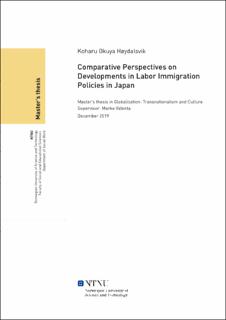| dc.description.abstract | This thesis aimed to explore and to get insights into Japan ́s “restrictive” labor immigration policy and to look at future prospects of acceptance of foreign workers. In this study, two comparative analyses were conducted; (1) a longitudinal case study on Japan ́s immigration policy over time, in order to understand the development and characteristics of Japan ́s policies; and (2) a comparative case study across countries (Canada, Australia and Singapore) to contrast policy elements in those countries with Japan and to further evaluate whether policy elements in the large-immigration countries might be adoptable in the case of Japan.
This study is the result of a desk study. Data sources were mainly from governmental documents, secondary literatures and reports from well-regarded international organizations. The collected data was qualitatively analyzed. The push-pull theory together with the human capital theory were mainly employed to analyze both migration decision-making processes from a migrant ́s perspective and migration policy decision-making processes from a policy maker ́s perspective. It was supplemented with the push-pull plus theory and the migration system theory.
The longitudinal case study showed that Japan has become a more open immigration country than before, opening several migration channels for prospective migrants with all skill-levels. The cross-country case study revealed that diversified migration programs and treatment differentiations based on skill-levels were common features among all those four countries. However, while Canada, Australia and Singapore recently restrict admission requirements for highly skilled workers and benefits and rights of low skilled migrants, Japan has relaxed the admission criteria. Also I discussed that Japan is urged to relax its policies even more to attract foreign migrants since the data shows that Japan has failed to take in as many labor migrants as the government ́s expectation.
It was also argued that Japan lacks “pull” factors from the migration system perspective. There are considerable cultural and social “push” factors in the Japanese society, such as barrier of language, cultural differences, and social acceptance. The government ́s attitude that views foreign labor migrants only as a temporary work force, not as a member of the society, deterred them from facilitation of a national integration policy which seems to have significant negative consequences on retaining foreign workers. As one of the possible future alternatives, I have suggested that use of a labor market test might function as a legitimate reason to approve recruitment of foreign migrants against the concerns regarding weakening social and cultural cohesion. Another suggested alternative was an implementation of a Canadian and Australian style of regional migration program by giving the local municipalities authority to arrange their own migration programs. It might help to resolve the severe labor shortage and the economic stagnation in the local communities, and importantly it might also encourage better social inclusion of foreign migrants to their local communities. | |
